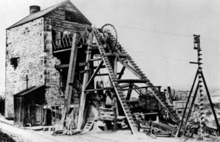 The former Meadow Shaft in 2022 The former Meadow Shaft in 2022 | |
| Location | |
|---|---|
| Location | Minera (Near Wrexham) |
| Country | Wales |
| Coordinates | 53°03′03″N 3°04′56″W / 53.0507582°N 3.0823232°W / 53.0507582; -3.0823232 |
| Production | |
| Products | Lead, Zinc |
| History | |
| Opened | 1845 |
| Active | 1845–1914 |
| Closed | 1914 |
| Owner | |
| Company | Minera Mining Company |


The Minera Lead Mines were a mining operation and are now a country park and tourist centre in the village of Minera near Wrexham, in Wrexham County Borough, Wales.
History
The first written record of lead mining at Minera dates back to 1296, when Edward I of England hired miners from the site to work in his new mines in Devon. Not all of them vacated the area, however, as mining went on until the Black Death in 1349, when it ended.
Its not clear when lead mining resumed in Minera. There are many old shafts in the area shown on the 1870s maps. The management of water levels was achieved either by the use of adits, or later by the use of steam pumping engines. At the location of the Lead Mines Country Park we know mining had resumed by the 18th century as there are references to the "City Land Mine work in Minera" in 1773 (City Lands was the early name for what is now called New Brighton). Mining was given a further boost when John Taylor & Sons (a large international mining company originating in Cornwall) formed the Minera Mining Company. This injected capital into the operations allowing more stationary steam engines, and also blast caves from down in the valley into the mines, for extra drainage. One of the shafts is called Taylors Shaft.
John Taylor & Sons had used a £30,000 investment at the time, yet the profits for 1864 alone were £60,000 (equivalent to over £4 Million in 2008). By 1900, the price of lead and zinc had fallen dramatically, while the price of coal used for the steam engine rose. The stationary steam engine stopped work in 1909. The owners sold off the mines and all assets by 1914.
Transport
For transport, the Mines had their own railway branch line, which connected with the end of the Wrexham and Minera Branch at Minera Limeworks. The mines also had their own steam locomotive, a Manning Wardle 0-6-0ST (Works No. 21) Henrietta. The lead ore would be taken to Wrexham for transport nationally, and coal brought back. The line was lifted in 1914 when the mines closed, but was relaid again in the 1920s to serve two silica clay pits (Graig Fawr quarry and Tir Celyn quarry) which were run by the newly formed Minera Silica Quarries Limited from 1926. The 'Minera Mineral Branch' appears in a 1947 list of GWR lines, so would have become a British Rail line in 1948. The track was lifted for the last time in the early 1960s.
Plans to build a tourist narrow gauge railway on the trackbed from the lead mines towards the Minera Limeworks were in the 1990 development plan, but were not progressed. Minera Quarry was still in use at the time (it closed in 1994). The Minera Quarry Trust was formed in 2005 to promote the use of the quarry for the local community, and in 2017 the quarry came under the ownership of the North Wales Wildlife Trust who purchased it from Tarmac. The quarry was formally opened to the public in June 2018.
Restoration
| This section does not cite any sources. Please help improve this section by adding citations to reliable sources. Unsourced material may be challenged and removed. (August 2024) (Learn how and when to remove this message) |
The workings and local area underwent massive restoration and regeneration funded by Wrexham County Borough Council and the Welsh Development Agency beginning in 1988 to make sure the lead, Zinc and lime spoil tips didn't contaminate local water supplies, the Engine house was rebuilt and fitted with replica machinery, as the original steam engine was removed in 1914. A visitor Centre was opened for public use, and the engine house is part of a tour. It is a site of tourism for Wrexham County Borough Council.
In 2004, the site was attacked by vandals, but this was repaired by the council in 2005. By 2024 much of the heavy replica woodwork supporting the winding gear had become rotten and dangerous, and so it was removed.
Sources
- Minera Lead Mines – official museum site
- The Story of Minera Lead Mines – Wrexham County Borough Council
References
- "Minera Lead Mines - WCBC".
- "To be sold to the Highest Bidder". Chester Courant. 6 July 1773. p. 3.
- "LNER Encyclopedia: The East and West Yorkshire Union Railway: Locomotives and Rolling Stock".
- Cooke, R A. Atlas of the Great Western Railway 1947. ISBN 9780906867655.
- "Official opening of Minera Quarry Nature Reserve". 22 May 2018. Retrieved 4 December 2024.
| Parks and open spaces in Wrexham | |
|---|---|
| within Wrexham | |
| within Wrexham County Borough | |
| Other | |